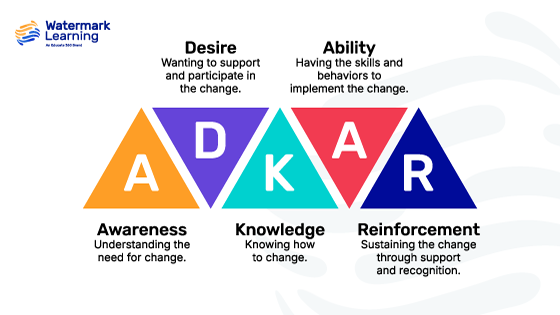Key Takeaways
- Why teams resist change. Understand the real reasons behind hesitation—and how to address them early.
- How to lead through uncertainty. Discover the leadership behaviors that help people stay steady during disruption.
- Which change models help. Get a simple breakdown of two proven frameworks: Kotter’s 8-Step Process and the ADKAR Model.
- What successful change looks like. Learn from real-world examples—plus steps you can take to lead change with confidence.
- How to take action right now. Learn practical steps you can use today to guide your team through change.
A Familiar Challenge
Imagine this: your organization has been running the same way for years. The processes are routine, the tools are familiar, and everyone knows what to expect. Then, a big change is announced out of nowhere—maybe a new platform, direction, or team restructure. Leaders lay out the benefits—cost savings, innovation, long-term goals—but the team’s reaction is… mixed. There’s hesitation, confusion, and quiet concern about how this will affect their daily work.
That kind of reaction is completely normal. Even when a change is the right move, it takes away certainty—and that’s uncomfortable. For leaders, the real challenge isn’t announcing the change. It’s helping people navigate their discomfort and get to the opportunity waiting on the other side.
Good change leadership isn’t just about checking boxes, whether you’re leading a small team or tackling a big, company-wide shift. It’s about giving people clarity, building trust, and helping them see where they belong in what’s coming next.
In this blog, we’ll break down what that looks like in real life—with practical guidance, examples, and ideas to help you navigate change management and build momentum as you go.
Why People Push Back Against Change (And What You Can Do About It)
Even when it’s for the better, change can make people uneasy—and that discomfort often shows up as resistance. It might seem like negativity, but it’s usually rooted in fear, uncertainty, or bad experiences with change in the past.
So, why do people push back? Here are a few of the usual reasons:
- The reason isn’t clear. When people don’t know why the change is happening, they’ll make up their own story—and that story usually isn’t helpful.
- They’re afraid they’ll fail. New systems and processes come with a learning curve; not everyone is confident they’ll keep up.
- It’s too much at once. When change piles up, even small shifts can start to feel overwhelming.
- Everyone reacts differently. Some people love change, while others need time to process it. Understanding those differences can have a big impact.
If you’re leading through change, the first step is seeing resistance for what it is—not a problem to fix, but a signal to pay attention to. Listen. Clarify. Give people space to talk through what’s bothering them. That’s how you build trust—which helps people move forward when things feel shaky.
Another thing to watch for? Change fatigue. Motivation starts to fade if your team has gone through wave after wave of change with no time to catch their breath or celebrate small wins. Leaders need to spot the signs of burnout and disengagement early to create space, refocus priorities, and give people room to recharge.
When you take the time to understand and deal with resistance early, you create an environment where people feel part of the process—not just swept up in it. That foundation makes it much easier to help people step into the change instead of backing away—and it sets the stage for the kind of leadership that really makes a difference.
Helping Teams Move Forward: Leadership Principles That Matter
Leading through change doesn’t require big speeches or brand-new policies. What makes a difference is showing up consistently, communicating clearly, and paying attention to how people are doing. Here are the leadership behaviors that help teams stay steady—even when everything else is shifting:
- Paint a clear picture. People want to know where the change is going and why it matters. They’re more likely to get on board when they can see the big picture.
- Model the change. If you want your team to try something new, lead by example.
- Give people what they need. Provide tools, information, or permission to make decisions to set your team up for success.
- Make it safe to speak up. People need to know they can ask questions or admit mistakes without being judged.
- Stay present and communicate consistently. Share updates, ask questions, and stay involved—especially after the kickoff, when the real work begins.
- Back up your middle managers. They’re the link between strategy and daily work. Give them the tools and context to guide their teams confidently.
These leadership habits create the foundation for trust and consistency—both of which make it easier to apply change models that stick.
Change Management Frameworks: Bringing Structure to Change
Leadership sets the tone, but structure helps keep things moving. A change management model gives your team a clearer path—and helps you stay focused on the right actions at the right time.
Two models you’ll see come up are:
- Kotter’s 8-Step Process – This model starts by creating a sense of urgency and ends with making the change stick long-term. Along the way, it walks you through building momentum, rallying a team, and celebrating quick wins.
- The ADKAR Model—This model is all about the individual. It breaks change into five stages—Awareness, Desire, Knowledge, Ability, and Reinforcement—and helps you spot where someone might be stuck.

Both frameworks offer solid guidance, but they’re not one-size-fits-all. The best leaders tweak them based on the team, the size of the change, and the company culture. Some teams like detailed plans and clear milestones. Others prefer flexibility and room to figure things out. Understanding how your team communicates and responds under pressure helps you tailor your approach, reduce confusion, and build buy-in faster.
And to be clear, a framework doesn’t replace communication. It’s there to back it up.
When you combine structure with empathy and strong leadership, change becomes less about surviving—and more about progressing. But frameworks only go so far without real-world commitment behind them. So, what does effective change leadership look like in practice? Let’s take a look.
What Success Looks Like: A Real-World Example
Adobe’s move from selling boxed software to offering subscriptions is a standout example of good change leadership. It wasn’t a small pivot—it changed how they delivered value, measured performance, and worked with customers.
Inside the company, they had to overhaul systems, retrain teams, and update how success was measured. On the outside, they worked to reset customer expectations and explain the long-term benefits. What made it work? Leaders stayed transparent, aligned teams early, and kept returning to the “why” behind the shift.
So, what’s the takeaway? Leading change isn’t about one big speech. It’s about staying consistent, keeping your team involved, and showing how the change connects to what really matters.
Not every change has to be massive. Even small teams can drive real improvement. Think of an HR group updating its hiring process to focus more on skills. With the right support and a clear goal, smaller efforts like that can ripple out and inspire bigger wins. And, if you’re wondering where to start, here are some practical steps you can take.
Moving Forward: Practical Steps You Can Take Now
You don’t have to have all the answers to lead and manage change well. Being steady matters most—showing up and helping people through the unknowns. Here are some practical ways to get started:
- Start talking early. Don’t wait until you have everything figured out. Keep people in the loop from the beginning.
- Make it relevant. Connect the change to what your team does every day so it feels real—not abstract.
- Ask for input. Build in space for feedback and let your team help shape how the change unfolds.
- Offer support. That might mean tools, training, or just giving people time to adjust.
- Celebrate small wins. Recognize progress as it happens—it helps build energy for what’s next.
- Watch for burnout. Not everything has to be urgent. Give people breathing room when they need it.
- Track what matters. Use check-ins, feedback, or simple usage stats to see what’s working—and tweak as needed.
When people feel included and supported, they stop seeing change as something to fear—and start seeing it as a path to something better.
Ready to Lead Change with Confidence? Let’s Talk.
Change is part of every organization’s journey. Whether you’re launching new tools, reworking processes, or shifting direction, strong leadership is what turns disruption into progress.
At Watermark Learning, we help leaders—no matter where they are in their journey—gain the confidence and skills to guide teams through change with clarity. If you’re ready to help your team navigate what’s next and come out stronger on the other side, reach out. The right training can make all the difference.
Jay Pugh, PhD
Dr. Jay Pugh is an award-winning leader, author, and facilitator with over 18 years of teaching and training experience. Currently serving as Head of Leadership Growth at Educate 360, he leads a robust team of external and internal facilitators who specialize in developing leadership capabilities within medium and large-scale businesses. His team works directly with business professionals, helping them become more effective leaders in their daily operations.
Dr. Pugh holds a Ph.D. in Instructional Management and Leadership, and his academic contributions include two published articles and a dissertation focusing on various educational topics. His extensive experience and academic background have established him as a respected voice in leadership development and educational management.

 New Horizons
New Horizons
 Project Management Academy
Project Management Academy
 Six Sigma Online
Six Sigma Online
 Velopi
Velopi
 Watermark Learning
Watermark Learning
 Login
Login





 New Horizons
New Horizons
 Project Management Academy
Project Management Academy
 Velopi
Velopi
 Six Sigma Online
Six Sigma Online
 Watermark Learning
Watermark Learning